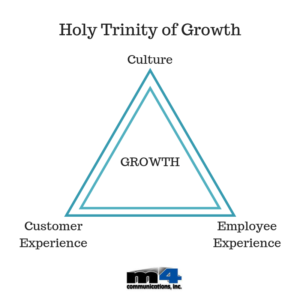The Holy Trinity of Growth
Growth remains the CEO’s biggest priority. Yet, only a small quantity of corporate leaders are successful in driving growth and sustaining that growth.
Successful leadership teams are always asking themselves the following three questions:
1. Does our mission, vision, and differentiation from our competition help us drive customer value?
2. Do we have the right people and are we engaging them to help us achieve our objectives?
3. Do we have an organization-wide culture that helps us grow?
At M4 Communications, we believe everything revolves around growth. This is the reason that we developed the Holy Trinity of Growth.
What is the Holy Trinity of Growth?
The Holy Trinity of Growth states that when you align culture with employee experience and customer experience, you achieve growth.
At the top, is culture.
Everything stems from culture. By definition, culture comprises those values, beliefs, and behaviors that determine how a company’s employees and management interact and conduct business. Culture starts at the top as the CEO and other C-suite members drive the culture. The hope is that they lead the organization in such a way that it survives and thrives.
The second component is employee experience.
Employee Experience is the sum of the interactions and perceptions of those interactions employees have about the organization in which they work. When you improve the employee experience, you get more engaged employees.
An engaged employee is enthusiastic about and committed to their work and workplace. They take positive action to further the organization’s reputation and interests. In addition, they advocate the organization to others.
Employee Engagement is the desired outcome you achieve when you optimize the employee experience and engage employees through a strategy that drives improved performance.
Management must drive and foster employee engagement. In the US, employee engagement has been stuck in the 33-34 percent range for almost 20 years. It’s been a tough nut to crack.
To engage employees, Management must do four key things.
Onboard employees.
Onboarding is not just about orienting new employees to the company’s policies and procedures. It also involves helping employees understand their job, performance expectations, and the culture; introducing them to co-workers and management; connecting them with sources that will enable them to do their jobs well, etc. New employees who go through a structured onboarding program are almost 70% more likely to still be with the organization after three years.
Help employees grow through meaningful employee development programs.
Employees want opportunities to advance within an organization. They also want autonomy, more responsibility, and respect. The best managers understand that their success and the organization’s success rely on employees’ achievements. So, they ensure they work with employees to create personal and professional growth plans, provide coaching and mentoring in addition to training, and ensure employees are engaged.
Give employees a sense of purpose.
Include employees in the business strategy so they know how they fit into the organization and with other teams, provide them with resources to help them perform their best, create an environment of open and clear communication, and provide meaningful incentives, rewards and recognition.
Create an effective voice of the employee (VoE) program.
Give employees an opportunity to provide feedback, and act on their feedback. According to Qualtrics, employees who say employers act on their feedback are 4x more likely to stay with the company than employees who don’t think their feedback changes anything.
The third component is customer experience.
When employees are engaged and understand how they fit in the organization, it’s easier for the CEO and other senior leaders to get them to buy into the customer experience (CX) vision, why it’s important, and their role in it. This enables them to take ownership for their piece of the CX effort.
It has been proven that engaged employees drive CX. According to Qualtrics XM Institute, CX leaders have 60 percent more engaged employees than CX laggards.
Only when you align culture, employee experience, and customer experience will you achieve growth and be able to sustain that growth.
So, what are you doing today to help you grow tomorrow?

